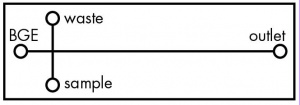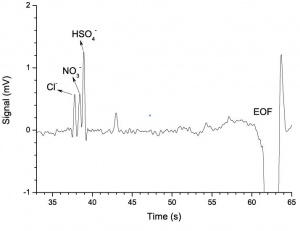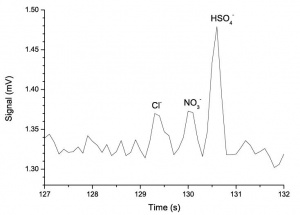Anions by MCE-C4D
The eDAQ C4D system was used to detect three inorganic anions, separated by microchip electrophoresis, by using contactless conductivity detection.
Introduction
The three inorganic anions Cl–, NO3– and HSO4– were separated using microchip electrophoresis (MCE). These anions were then detected using the eDAQ C4D system.
Equipment Required
- ER255 or ER455 Microchip Electrophoresis bundles, including:
- ER225 C4D Data System
- ET225 Micronit Platform
- ER230 High Voltage Sequencer (one or two units)
- ET145-4 CE Microchip (45 mm) kit
- PowerChrom and Sequencer softwares
Conditions
- Background Electrolyte (BGE) = 70 mM TRIS/CHES with 1ppm HDMB, where TRIS is Tris(hydroxymethyl)aminomethane, CHES is 2-(Cyclohexylamino)ethanesulfonic acid, and HDMB is hexadimethrine bromide
- Samples = 100 μM and 10 μM Cl–, NO3– and HSO4– in deionised water.
Data and Limit of Detection
Figure 1 shows the electropherogram of the 100 μM Cl–, NO3– and HSO4– solution. In order to measure the limit of detection of the anions, a 10 μM solution of the same analytes was analyzed. The electropherogram is shown in Figure 2.
Using the definition of limit of detection as equal to three times the standard deviation of signal (during four seconds before the first peak), the limit of detection is 3.7 μM for Cl– and NO3–, and 1.3 μM for HSO4–.


